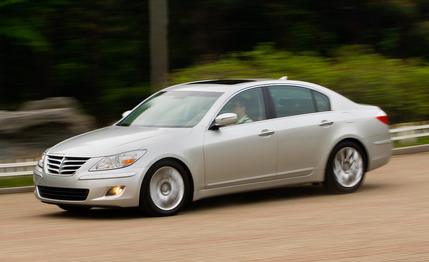
 Short Take Road Test
Short Take Road Test
Hyundai established a beachhead in the U.S. market with affordable economy cars in 1985. Over the years, the number of models offered increased, and steady improvements in quality resulted in steady gains in the market. Now Hyundai is headed upmarket, and the full-size Genesis sedan is its first entry. It has rear-wheel drive, an optional V-8 engine, and all the indulgences one finds in a big luxury car but at a price significantly lower than the Germans or Japanese charge.
Sounds like a remake of the Toyota story line of 1989, when that Japanese automaker launched the Lexus luxury brand with the big LS400 sedan. At least Hyundai wants us to think it’s the same story. That Lexus changed the automotive landscape, and we’ve seen plenty of imitators try to repeat that feat, but none with the Lexus effect. Moreover, the price range the Genesis plays in—base price is $33,000 for the V-6 and $38,000 for the V-8—is both more crowded and more competitive than it was in 1989. And the Genesis doesn’t enjoy a new brand and dealer network as Lexus did. So, is the Genesis the second coming of the LS400 or just another heroic but failed attempt at redefining luxury?
The LS400 earned its fame not just for offering its luxury for two-thirds the price of Mercedes or BMW equivalents, but for refinement, attention to detail, and a superb dealer experience. All of these qualities persist throughout the Lexus lineup and have been adopted by the German competition as well. From an engineering standpoint, the Genesis makes a strong case for being considered an equal in that crowd. Take, for example, what Hyundai has done to cancel out cabin noise. More than 275 feet of structural adhesive (that’s glue) is applied to the body shell to damp vibrations and improve stiffness. The roof panel alone has six anti-vibration pads, and the floor is covered with them, too. Even some of the open space inside the body pillars is stuffed with insulation. The windshield and door use double-paned glass for more sound insulation. If the Genesis isn’t quiet, it’s not for a lack of trying.
The suspension, as well, is as sophisticated as they come. The four main links on the two front corners are each attached to the hub with a ball joint. This arrangement locates the steering axis much closer to the center of the tire’s contact patch than it would with a conventional unequal-length control-arm suspension, which should improve steering feel and reduce bump steer. It’s an expensive setup, made more so by the use of lightweight aluminum for the links, knuckles, and brackets, and further evidence that Hyundai is making a serious effort here. That front suspension setup also hints at a yet-unannounced four-wheel-drive version because that arrangement reduces torque steer. The rear suspension knuckles are aluminum as well, connected to the chassis with five links. The power steering is hydraulically assisted, but an electric pump supplies the fluid pressure, which Hyundai says increases fuel economy by 2.7 percent.